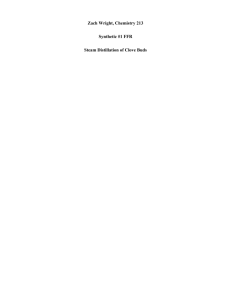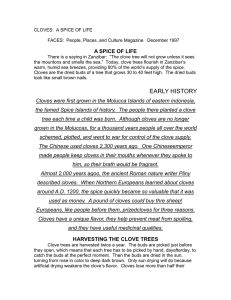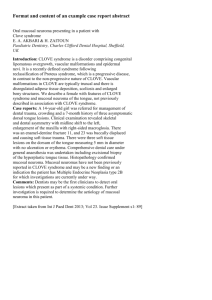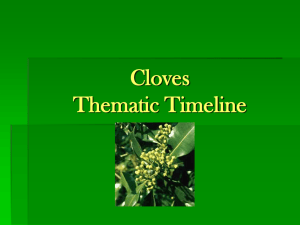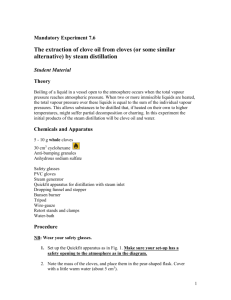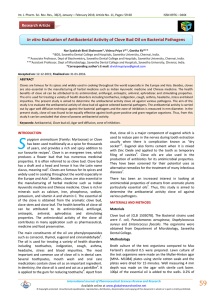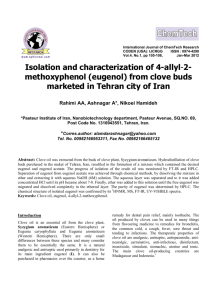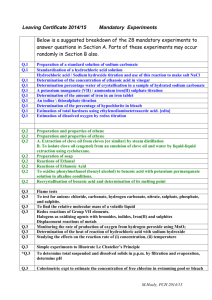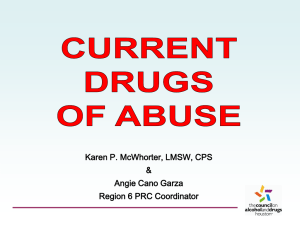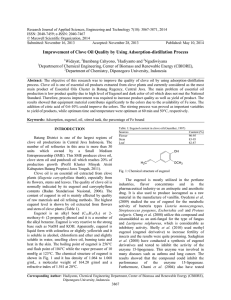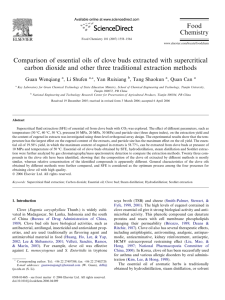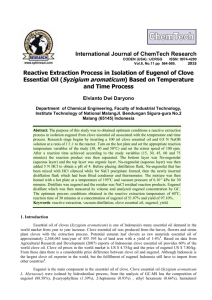Isolation of Volatile Oil by Extraction. Exp.2
advertisement
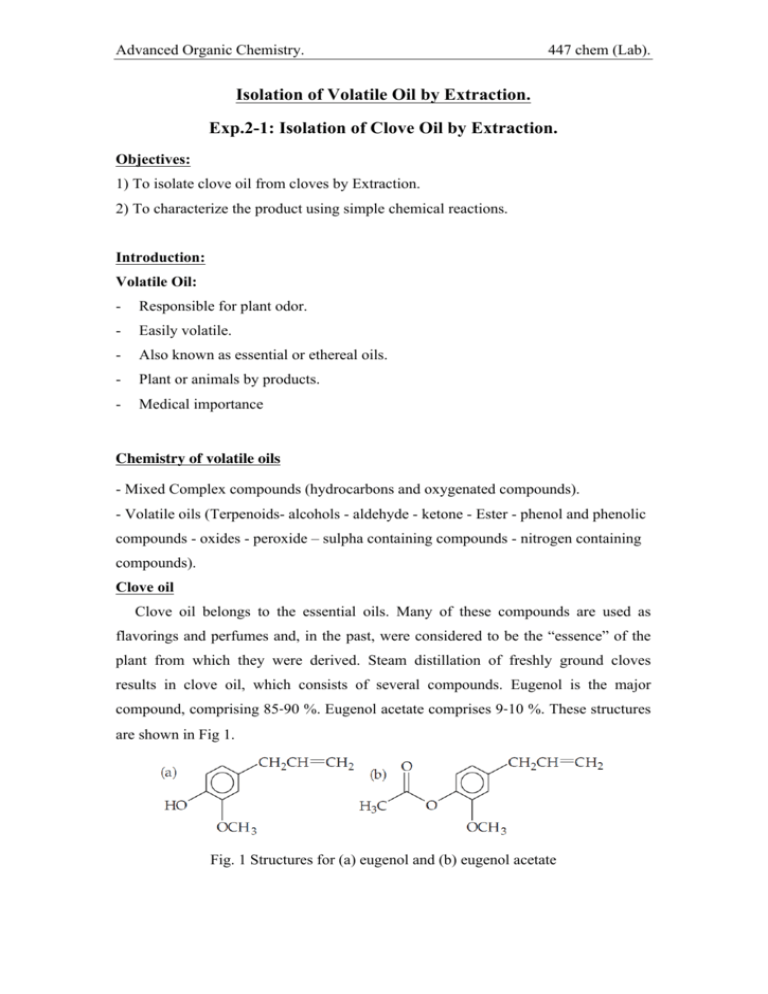
Advanced Organic Chemistry. 447 chem (Lab). Isolation of Volatile Oil by Extraction. Exp.2-1: Isolation of Clove Oil by Extraction. Objectives: 1) To isolate clove oil from cloves by Extraction. 2) To characterize the product using simple chemical reactions. Introduction: Volatile Oil: - Responsible for plant odor. - Easily volatile. - Also known as essential or ethereal oils. - Plant or animals by products. - Medical importance Chemistry of volatile oils - Mixed Complex compounds (hydrocarbons and oxygenated compounds). - Volatile oils (Terpenoids- alcohols - aldehyde - ketone - Ester - phenol and phenolic compounds - oxides - peroxide – sulpha containing compounds - nitrogen containing compounds). Clove oil Clove oil belongs to the essential oils. Many of these compounds are used as flavorings and perfumes and, in the past, were considered to be the “essence” of the plant from which they were derived. Steam distillation of freshly ground cloves results in clove oil, which consists of several compounds. Eugenol is the major compound, comprising 85‐90 %. Eugenol acetate comprises 9‐10 %. These structures are shown in Fig 1. Fig. 1 Structures for (a) eugenol and (b) eugenol acetate Advanced Organic Chemistry. 447 chem (Lab). Experimental Procedure: Part A: Isolation of Clove Oil Step 1 Procedure Weigh 10 g of dry ground cloves. Transfer the ground cloves to a 500 mL round‐bottom flask. Add 150 mL of distilled water. Start distillation process using Clevenger-type (Fig. 1) Turn on the heating mantle for 2h. Fig. 1 2 3 Collect the oil in small measuring cylinder. Add anhydrous Na2SO4. 4 Measure the volume of the oil. 5 TLC using Benzene - ethyl acetate (9:1 V/V) 6 Use Vanillin sulpharic acid reagent. 7 Report the weight and percent yield of clove oil to your instructor. cloves oil % = vol. of cloves oil x 100 Wt. of plant (cloves) Part B: Characterization of the Isolated Clove Oil Eugenol contains a carbon‐carbon double bond and an aromatic hydroxyl group called a phenol. These functional groups provide the basis for simple chemical tests used to characterize the clove oil. - A solution of bromine (Br2) in chloroform decolorizes as Br2 reacts with the double bond to form a colorless compound, as shown in Equation 3. A positive test is the disappearance of the Br2 color. - A potassium permanganate (KMnO4) solution can oxidize a double bond at room temperature to form a 1,2‐diol with the simultaneous reduction of Mn7+ in manganese oxide (MnO2), as shown in Equation 4. A positive test is the Advanced Organic Chemistry. 447 chem (Lab). disappearance of the purple KMnO4 and the appearance of MnO2 as a brown precipitate. - Phenols (ArOH) react with the Fe3+ ion in iron(III) chloride (FeCl3) to give complexes that are blue, green, red, or purple, as shown in Equation 5. The color may last for only a few seconds or for many hours, depending on the stability of the complex. In this experiment, you will steam distill clove oil from freshly ground cloves. Following the distillation, clove oil and water will be present in the receiving flask. Because clove oil will be a minor fraction of the distillate, the clove oil must be extracted from the water into an organic solvent such as dichloromethane. Removing dichloromethane leaves clove oil as the product. Procedure: 1) Dissolve the clove oil in 2‐3 mL of methanol. 2) Obtain six test tubes and label them 1‐6. Label tubes 2, 4, and 6 as “blank”. Add 1 mL of methanol to all 6 test tubes. 3) Add 5 drops of clove‐oil solution to tubes 1, 3, and 5. Gently swirl each tube. 4) Add 5 drops of bromine in chloroform to tubes 1 and 2. Gently swirl and record your observation. 5) Add 5 drops of KMnO4 solution to test tubes 3 and 4. Gently swirl and record your observation. 6) Add a few drops of FeCl3 solution to test tubes 5 and 6. Gently swirl and record your observation. Laboratory Safety Precaution 1) Anhydrous sodium sulfate is irritating and hygroscopic. 2) Bromine and potassium permanganate are toxic and irritating. Prevent eye, skin, and clothing contact. Advanced Organic Chemistry. 447 chem (Lab). Exp.2-2: Extraction of Thymus Oil Objectives: 1) To isolate Thymus Oil by Extraction. Experimental Procedure: Isolation of Thymus Oil Step Procedure Weigh 10 g of dry Thymus. Transfer the Thymus to a 500 mL round‐bottom flask. Add 150 mL of distilled water. 1 Start distillation process using Clevenger-type (Fig. 1) Turn on the heating mantle for 2h. Fig. 1 2 Collect the oil in small measuring cylinder. 3 Add anhydrous Na2SO4 (drying). 4 Measure the volume of the oil. 5 TLC using Benzene - ethyl acetate (9:1 V/V) 6 Use Vanillin sulpharic acid reagent. Report the weight and percent yield of Thymus oil to your instructor. 7 Thymus oil % = vol. of Thymus oil Wt. of plant (Thymus) x 100 Advanced Organic Chemistry. 447 chem (Lab). Exp.2-3: Extraction of Salvia Oil Objectives: 1) To isolate Salvia Oil by Extraction. Experimental Procedure: Isolation of Salvia Oil Step Procedure Weigh 10 g of dry Salvia. Transfer the Salvia to a 500 mL round‐bottom flask. Add 150 mL of distilled water. 1 Start distillation process using Clevenger-type (Fig. 1) Turn on the heating mantle for 2h. Fig. 1 2 Collect the oil in small measuring cylinder. 3 Add anhydrous Na2SO4. 4 Measure the volume of the oil. 5 TLC using Benzene - ethyl acetate (9:1 V/V) 6 Use Vanillin sulpharic acid reagent. Report the weight and percent yield of Salvia oil to your instructor. 7 Salvia oil % = vol. of Salvia oil Wt. of plant (Salvia) x 100
